
The Detroit Masonic Temple is the world's largest Masonic Temple. Located in the Cass Corridor of Detroit, Michigan, at 500 Temple Street, the building serves as a home to various masonic organizations including the York Rite Sovereign College of North America. The building contains a variety of public spaces including three theaters, three ballrooms and banquet halls, and a 160 by 100 feet clear-span drill hall.

Rosemark is an unincorporated residential and farm community located along Tennessee State Route 14 in northeastern Shelby County, Tennessee, United States. It had a population of 2,315 people in 2010.

The Masonic Hall of Hiram Masonic Lodge No. 7 is a historic Gothic revival building on South 2nd Avenue in Franklin, Tennessee. Constructed in 1823, it is the oldest public building in Franklin. It is nationally significant as the site of negotiations leading to the Treaty of Franklin, the first Indian removal treaty agreed after passage of the 1830 Indian Removal Act. It was declared a National Historic Landmark in 1973. It continues to serve the local Masonic lodge.

The Scranton Cultural Center at the Masonic Temple is a theatre and cultural center in Scranton, Pennsylvania. The Cultural Center's mission statement is "to rejuvenate a national architectural structure as a regional center for arts, education and community activities appealing to all ages." The Cultural Center hosts national Broadway tours; professional and local musical and dramatic theatre offerings; local, regional and national orchestral and popular music, dance and opera; comedians, lecturers, art exhibits, a children's and performing arts academy and various classes as well as fundraiser galas and special events including proms, luncheons, private parties and is a popular wedding ceremony and reception venue. It is listed on the National Register of Historic Places.

The Masonic Temple is an historic former Masonic building at 339-341 State Street in Springfield, Massachusetts. The four story Neo-Classical building was built in 1923 to serve as the headquarters of the local Masonic lodge. It occupies a prominent position opposite the Springfield Armory, just outside the downtown area. The building, which is no longer owned by the Masons, was listed on the National Register of Historic Places in 1983.
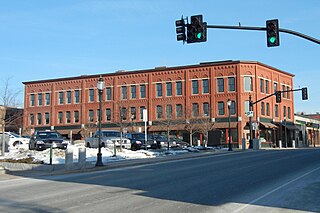
The Masonic Block is an historic commercial block in Reading, Massachusetts. This three story brick building is distinctive in the town for its Renaissance Revival styling. It was built in 1894 by the local Reading Masonic Temple Corporation, and housed the local Masonic lodge on the third floor. The building was listed on the National Register of Historic Places in 1984.
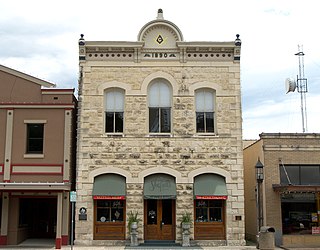
The Masonic Building in Kerrville, Texas is an Italianate building built in 1890. Alfred Giles was the architect. Kerrville Masonic Lodge #697 made its home in the building until 1927. The first floor later housed a post office and grocery store. The building was listed on the National Register of Historic Places in 1984. It was restored during 1984-1985 using rare woods and including work by special craftsmen.

The Chester Masonic Lodge and Community Building is a historic community building in Chester, Arkansas. It is a two-story rectangular wood-frame structure, designed to house a church and community space on the ground floor, and Masonic lodge facilities on the upper floor. It was built in 1942, replacing a 1903 building of similar function that stood at another location and was torn down to build a school. Significant elements of the old building were reused in the construction of the new building.
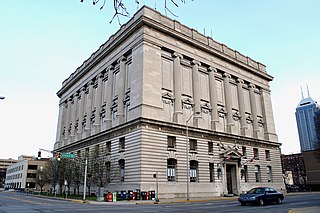
The current Indianapolis Masonic Temple, also known as Indiana Freemasons Hall, is a historic Masonic Temple located at Indianapolis, Indiana. Construction was begun in 1908, and the building was dedicated in May 1909. It is an eight-story, Classical Revival style cubic form building faced in Indiana limestone. The building features rows of engaged Ionic order columns. It was jointly financed by the Indianapolis Masonic Temple Association and the Grand Lodge of Free and Accepted Masons of Indiana, and was designed by the distinguished Indianapolis architectural firm of Rubush and Hunter.

The Old Masonic Hall, also known as Benicia Masonic Hall, is a historic building in Benicia, California. Constructed by Benicia Masonic Lodge No. 5 in summer 1850, on land donated by Alexander Riddell and with lumber donated by Benicia founder Robert Semple, it was the first purpose build Masonic Hall in California. It was occupied by the lodge October 14, 1850, and formally dedicated December 27, 1850.

The Masonic Female College and Cokesbury Conference School is a historic building in Cokesbury, South Carolina, that was the home of several different educational institutions in the century from 1854 to 1954. Together with the adjacent village of Old Cokesbury, it is now listed on the National Register of Historic Places as an historic district.
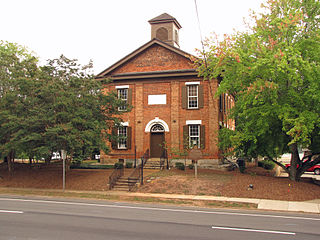
The Old Seminary Building, also known as Old Masonic Lodge or Lawrencevile Female Seminary Building, is a building in Lawrenceville, Georgia, USA, that was built in 1854 in Greek Revival and Federal style. It was originally constructed as a school but has had various tenants through the years, most notably Lawrenceville Lodge No. 131 Free and Accepted Masons, who used the second story of the building for meetings for more than a century.
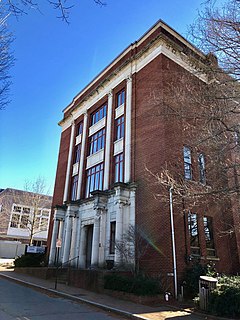
The Masonic Hall in Waynesville, North Carolina is a historic Masonic Lodge constructed in 1927 as a meeting hall for a local area Masonic Lodge.
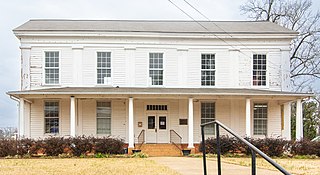
The Old Masonic Hall in Louisville, Mississippi, also known as Community House, and as Chamber of Commerce, is a historic building built in 1851. It was listed on the National Register of Historic Places in 1994 and was designated a Mississippi Landmark in 2007. It is a notable example of Greek Revival style architecture.
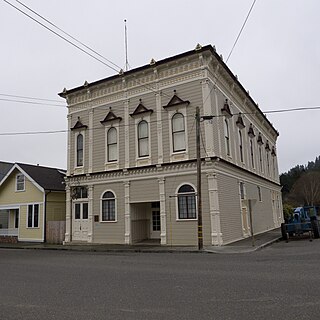
The Masonic Temple in Ferndale, California is located at 212 Francis Street, in an Eastlake-Stick style building built in 1891. The Masonic Hall is a contributing property in the Ferndale Main Street Historic District which was added on 10 January 1994 to the National Register of Historic Places. Ferndale Masonic Lodge F & A. M. #193 holds meetings in the building.

The Auburn Masonic Temple, also known as the Auburn Masonic Hall and the John H. Robinson Memorial Masonic Temple, is an historic two-story Masonic building located at 948 Lincoln Way on the Central Square in Auburn, California. In 1913 Eureka Lodge No. 16, Free and Accepted Masons, chartered in 1851, bought two adjoining one-story redbrick commercial buildings on this site for $17,000 and commissioned architect Allen D. Fellows to add a second-story to them with a unified facade with an entrance to the second floor placed in on the left side of the first floor street front. Fellows designed the expansion in the Beaux-Arts style of architecture with brick walls and a terracotta facade and it was built in 1914-1915 by Herdal Brothers of Auburn and dedicated on April 25, 1916. The terracotta was supplied by Gladding, McBean and Company which is still in existence. The first floor, which once housed a J. C. Penney store, continues to be used for retail and office space while the second floor continues to be used by Eureka Lodge and other Masonic-related bodies. On December 19, 2011, the building was added to the National Register of Historic Places.

The Grafton District Schoolhouse No. 2, also known locally as the Old Fire Station, is a historic civic building at 217 Main Street in Grafton, Vermont. Built about 1835, it has served as a school, fire station, Masonic hall, tin shop, undertaker's shop, and as the clubhouse of a local brass band. Despite some alteration, it is a well-preserved example of a mid-19th century Greek Revival schoolhouse. It was listed on the National Register of Historic Places in 2005.
The Saratoga Masonic Hall is a two-story brick building in downtown Saratoga, Wyoming that houses Saratoga's Masonic lodge. Established in 1892, the lodge was the fourteenth to be established in Wyoming. After a time in rented space, the lodge bought the Couzens and Company Block in 1893, using the second floor for meetings and leasing the ground floor to storekeeper A. Johnson Dogget. From 1895 the ground floor was used as a school. The Masons allowed a variety of other organizations to use the building, including the Odd Fellows, Knights of Pythias, Pythian Sisters, Union Fraternal League, Modern Woodmen, Women of Woodcraft, Job's Daughters, the Republican Party and the Ku Klux Klan.



















